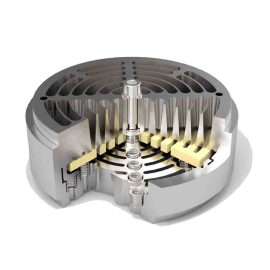Compressor Piston Rod
20Cr13, 38CrMoAlA, 42CrMoE, high-frequency quenching nitriding treatment or surface spray WC, so that the piston rod can obtain a higher Rockwell hardness value.
Transfer of Motion:
The primary function of the piston rod is to convert the rotational motion of the crankshaft into the linear motion of the piston. This motion is necessary for the piston’s reciprocating action within the cylinder, which compresses the gas.
Alignment and Stability:
The piston rod ensures that the piston remains aligned and stable as it moves up and down the cylinder. This alignment is crucial for maintaining the efficiency and reliability of the compressor.
Bearing the Load:
The piston rod bears significant mechanical loads during the compression process, including the forces exerted by the gas pressure within the cylinder and the inertial forces due to the piston’s motion. It must be strong and durable to withstand these stresses.
Piston and Rod Reconditioning
All pistons and rods are inspected to assess how to proceed with reconditioning and to ensure their suitability for re-use. Piston reconditioning may include re-machining of grooves and re-anodizing. Rod reconditioning may include machining, grinding, polishing and the application of specialized spray coatings. Finally, all parts are re-assembled including piston and rider rings.
Design and Construction
Material:
Piston rods are typically made from high-strength materials such as alloy steel, stainless steel, or other durable metals. These materials are chosen for their ability to withstand high stresses, resist wear, and endure corrosive environments.
Surface Treatment:
To enhance durability and reduce friction, piston rods often undergo surface treatments such as hardening, nitriding, or coating with materials like chromium. These treatments improve the wear resistance and extend the lifespan of the rod.
Geometry:
The design of the piston rod must ensure a precise fit with both the piston and the crankshaft. It usually features a cylindrical shape with a polished surface to minimize friction and wear. Some designs may include a threaded or flanged end for secure attachment.
The compressor piston rod is a vital component that plays a key role in the operation of reciprocating compressors. Its primary functions include transferring motion from the crankshaft to the piston, maintaining alignment, and bearing the mechanical loads during compression. Made from high-strength materials and often treated for enhanced durability, piston rods are designed to withstand the demanding conditions within a compressor. Proper maintenance and regular inspection are essential to ensure the longevity and efficient performance of the piston rod and, consequently, the compressor itself.










